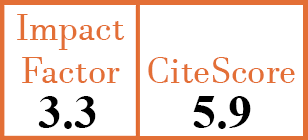Full Papers
Clinical and serological features of systemic sclerosis patients, according to different geographic areas: insights from an observational, cross-sectional study of two independent cohorts
V. Liakouli1, H. Hamoud2, M.I. Risha3, M.E. Hanafy4, A. Moshrif5, R.A. Abdel-Magied6, G.M. Omar7, A.M. Elsayed8, A. Elhefny9, S. Mobasher10, M. Abo Gabal11, M. Hassanien12, F.H. El Nouby13, K. Abdelgalil14, G. Forte15, L. Navarini16, P. Ruscitti17, F. Ciccia18, R. Giacomelli19
- Rheumatology Unit, Department of Precision Medicine, University of Campania Luigi Vanvitelli, Naples, Italy. vasiliki.liakouli@unicampania.it, vasiliki_liakouli@yahoo.it
- Department of Rheumatology, University of Al-Azhar, Cairo, Egypt.
- Department of Rheumatology, University of Al-Azhar, Cairo, Egypt.
- Department of Rheumatology, University of Al-Azhar, Cairo, Egypt.
- Department of Rheumatology, University of Al-Azhar, Cairo, Egypt.
- Department of Rheumatology and Rehabilitation, University of Minia, Cairo, Egypt.
- Department of Rheumatology and Rehabilitation, University of Minia, Cairo, Egypt.
- Department of Rheumatology, University of Ain Shams, Cairo, Egypt.
- Department of Rheumatology, University of Ain Shams, Cairo, Egypt.
- Department of Rheumatology, University of Ain Shams, Cairo, Egypt.
- Department of Rheumatology, University of Ain Shams, Cairo, Egypt.
- Department of Physical Medicine, Rheumatology and Rehabilitation, University of Assuit, Egypt.
- Department of Physical Medicine, Rheumatology and Rehabilitation, University of Assuit, Egypt.
- Department of Rheumatology and Physical Medicine, University of Aswan, Egypt.
- Rheumatology Unit, Department of Precision Medicine, University of Campania Luigi Vanvitelli, Naples, Italy.
- Clinical and Research Section of Rheumatology and Clinical Immunology, Fondazione Policlinico Campus Biomedico, Rome; and Rheumatology and Clinical Immunology, Department of Medicine, University of Rome Campus Biomedico, School of Medicine, Rome, Italy.
- Department of Biotechnological and Applied Clinical Sciences, University of L'Aquila, Italy.
- Rheumatology Unit, Department of Precision Medicine, University of Campania Luigi Vanvitelli, Naples, Italy.
- Clinical and Research Section of Rheumatology and Clinical Immunology, Fondazione Policlinico Campus Biomedico, Rome; and Rheumatology and Clinical Immunology, Department of Medicine, University of Rome Campus Biomedico, School of Medicine, Rome, Italy.
CER18632
2025 Vol.43, N°8
PI 1472, PF 1480
Full Papers
Free to view
(click on article PDF icon to read the article)
PMID: 40556620 [PubMed]
Received: 15/02/2025
Accepted : 07/04/2025
In Press: 23/06/2025
Published: 01/08/2025
Abstract
OBJECTIVES:
To evaluate the clinical, and serological features and treatments in two independent cohorts of Italian and Egyptian systemic sclerosis (SSc) patients, according to geographic areas.
METHODS:
3 Italian and 5 Egyptian centres participated in patient recruitment in 2017. The demographic, clinical, and serological data were collected and defined according to the previously developed severity score and activity index. The database included 261 consecutive Italian patients (242 women/19 men) and 197 Egyptian patients (177 women/20 men), all of whom fulfilled the classification criteria of ACR/EULAR 2013 and criteria proposed by LeRoy and Medsger.
RESULTS:
Egyptians were younger, had an earlier onset of both the first non-Raynaud’s and Raynaud’s phenomenon and a more severe modified skin score. A greater percentage of Egyptians had the active form of the disease, a pulmonary arterial pressure estimated by echocardiography>35mmHg than Italians and interstitial lung disease. The severity score was higher in Egyptians, the frequency of anti-topoisomerase I (ATA) was higher in Italians, and Egyptians were more likely to be negative for both anticentromere and ATA antibodies than Italians. Egyptians had higher rates of synthetic disease-modifying antirheumatic drugs use than Italians; Italians but not Egyptians were under treatment with vasoactive therapy. Notably, Egyptians affected by the limited form of the disease exhibited a more severe clinical course when matched with their Italian counterparts, characterised by higher modified Rodnan skin score (mRSS), more frequent pulmonary involvement, increased frequency of ischaemic digital ulcers, earlier onset of symptoms, and higher severity scores.
CONCLUSIONS:
Clinical differences may be shown between Italian and Egyptian SSc patients.


